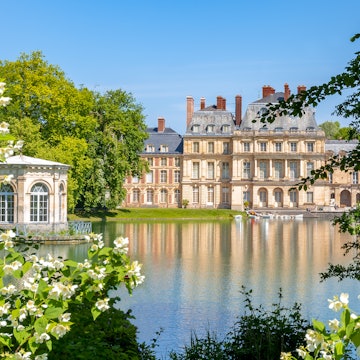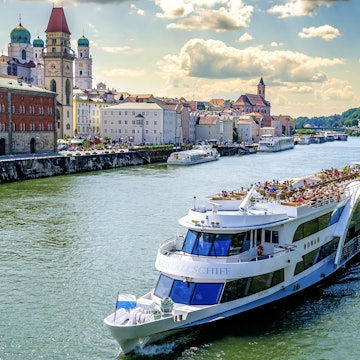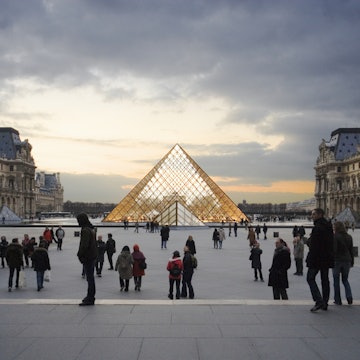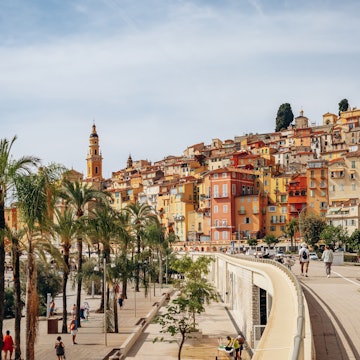

The Longues-sur-Mer Battery is just one of the German artillery pieces still aiming out to sea. pedrosala / Shutterstock
The largest seaborne invasion ever seen was launched from choppy waters onto the wind-whipped shores of German-held Normandy in the early hours of 6 June 1944. With the 75th anniversary of D-Day being marked in France this week, and commemorative events and exhibitions lined up throughout the year, there has never been a more insightful time to visit.
This road trip encompasses the standout sights that witnessed the most ferocious and courageous fighting, commemorated today by poignant monuments.

Caen
Unleashed with watertight secrecy, Operation Neptune (D-Day) initially gained a tenuous toehold on French soil, before two million Allied troops found themselves in France by August 1944. Heavily devastated during the Battle of Normandy, the handsome – and often stunning – city of Caen is your starting point, especially the thought-provoking Le Mémorial de Caen with its detailed overview of how WWII shattered this French region. Don’t miss the gripping film or the haunting footage of the Nuremberg trials and wander the austere 70m-length of General Richter's Underground Bunker, on-site.
Juno Beach
From Caen, drive along the D79 to Juno Beach at Courseulles-sur-Mer to explore today’s tranquil sand dunes, stormed by the Canadian Army on D-Day; the on-site Juno Beach Centre commemorates Canada’s costly, bloody sacrifice. A summer visit ties you in with one of the centre’s guided beach tours, which also accesses the German bunker here. En route to Juno Beach, ponder a detour to the 1944 Radar Museum in Douvres-la-Délivrande to gauge the role the technology played in WWII while perusing a Würzburg radar antenna at one of Germany’s key radar stations in Normandy.
Arromanches-les-Bains and Mulberry Harbours
Head west along the D514 past Gold Beach – attacked by the British 50th Infantry on D-Day – to Arromanches-les-Bains, site of perhaps the most ambitious logistical feat of the attack. Set to reopen for the 75th anniversary in 2019, the Musée du Débarquement details how the artificial Mulberry Harbours (temporary ports for the offloading of cargo crucial to the invasion) were engineered. The film in the Arromanches 360° Circular Cinema is a highly informative introduction to this crucial endeavour. Try to visit at low tide, when the vestiges of the Mulberry Harbours are visible above the water line.
Longues-sur-Mer Battery
From Arromanches-les-Bains, continue along the D514 to Longues-sur-Mer, where a formidable battery of vast 150mm German artillery pieces still aim out to sea, part of Germany’s formidable Atlantic Wall coastal defences. Take time to examine the gun emplacements (the first casemate is fenced off as it was damaged, but the others are accessible).

Bayeux
Drive south along the D104 from Longues-sur-Mer towards Bayeux; at the intersection with the D613 on the outskirts of town, turn right and follow the signs for the informative Musée de la Bataille de Normandie and the Bayeux War Cemetery, the largest of the Normandy Commonwealth cemeteries, where 4,848 soldiers from the UK and ten other nations are interred. On the other side of the road stands a memorial to 1,807 Commonwealth soldiers whose remains were never found. Bayeux may be most famed for its beautiful tapestry depicting the conquest of England by William the Conqueror in 1066, but the historic town was the first town to be liberated in the early hours of 7 June 1944.
Omaha Beach and the Normandy American Cemetery and Memorial
From Bayeux, drive north along the D6 to Port-en-Bessin, turn left onto the D514 to Colleville-sur-Mer and follow the signs to the superb Overlord Museum – chronicling the battle from the landings to the liberation of Paris – and then move onto the Normandy American Cemetery & Memorial. The most evocative D-Day sight on the Normandy coast, the endless white marble crosses and Stars of David at the cemetery are overwhelming. Almost 70 hectares in size, the huge plot is a transfixing testament to the slaughter that took place on Omaha Beach below. The final resting ground of almost 9400 Americans who lost their lives in WWII, the cemetery also sets the scene for the opening shots of the gut-wrenching WWII drama, Saving Private Ryan.
A substantial semi-circular colonnaded memorial focuses on a bronze statue: The Spirit of American Youth Rising from the Waves. Also interred on the grounds is a time capsule containing news reports of the D-Day landings, set beneath a granite slab inscribed with the instruction: ‘To be opened June 6 2044’. Don’t overlook the Visitor Centre, which retells the landings in dramatic fashion, while English-language tours explore the cemetery grounds at 2pm daily (and at 11am between mid-April and mid-September). On Omaha Beach, a few German bunkers survive, as well as some remains of Mulberry Harbour, visible at very low tide.
La Pointe du Hoc
Continue west along the D514 for 10km to this promontory, the highest point between Omaha Beach to the east and Utah Beach to the west, heavily fortified by the Germans with large 155mm artillery gun emplacements. The artillery pieces required disabling and La Pointe du Hoc was the scene of a daring assault in the early hours of 6 June 1944, when 225 US Army Rangers scaled the perilously steep 30m-high cliffs. After capturing the site, the soldiers discovered the guns had been moved inland, so set off to successfully find and disable them, while enduring enemy counterattacks. By the time the force was relieved on 8 June, only around 90 men had survived. The heroic attack is commemorated by battle-scarred concrete bunkers and casemates and a dagger-shaped memorial; an informative visitor centre is also at the site.
Utah Beach
Continue west along the D514 to link up with the N13 and then head northeast along the D913 to conclude the drive at Utah Beach around 45km from La Pointe du Hoc. The most westerly D-Day landing site, this stretch of sand was taken by the US 4th Infantry Division, facing only light resistance, an amphibious assault chronicled in the absorbing Musée du Débarquement de Utah Beach.
Visiting Normandy’s essential WWII sights by minibus
A host of minibus tours roam across Normandy to the D-Day sights, which can be an excellent way of lassoing in the crucial must-sees. Le Mémorial de Caen Runs excellent tours year-round, taking in many sights and includes a visit to the museum itself in Caen, while Normandy Sightseeing Tours is an efficient Bayeux-based outfit. Also check out our guide to the story of the D-Day beach landings.
Where to sleep
Château de la Ferrière is a fantastic 18th century chateau, located in splendid grounds between Bayeux and the coast.
La Maison de Famille is a grand, historic and pleasant B&B in Caen.
Where to eat
L'Alchimie serves superbly presented modern French cuisine in Bayeux.
À Contre Sens offers vibrantly creative French dishes in a stylish setting in Caen.
This article was first published in August 2018. It was updated in June 2019.
https://shop.lonelyplanet.com/products/lonely-planets-best-in-travel-paperback-2019














